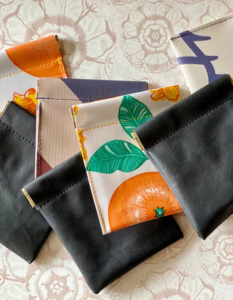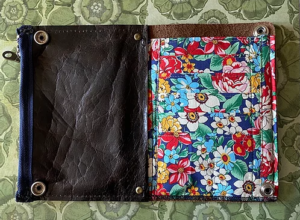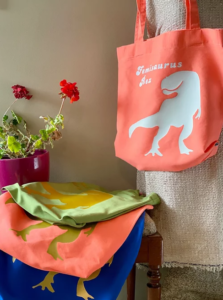Maker Spotlight: Amanda Brown
Amanda is a local designer in Saskatoon with a sustainable label called Scarlett Dahlia which launched back in 2013. Since she was a young girl, she was passionate about designing clothing, accessories, and keeping herself busy with different creative projects. As an adult, she continues flourishing her artsy side and chasing a few different creative endeavours! One of the biggest projects Amanda is working on is her business, Scarlett Dahlia. She designs and creates all pieces in her home studio and has come up with a range of products such as wallets, scarves, and shawls. Along with the clothing brand, Amanda is a multi-talented visual, textile, and makeup artist. She has a deep-rooted connection and understanding of sustainable slow fashion, implementing her beliefs into all aspects of her life and business development.
 Sustainable Focus
Sustainable Focus
The roots to the brand, Scarlett Dahlia, is based on a sustainable business plan, having a small-impact and sticking as close to zero-waste as possible. Amanda strongly believes in re-purposing and re-using old materials to create new, updated pieces. She is also mindful of the pieces she is repurposing and mainly uses materials that would otherwise end up in the landfill. She uses materials from a variety of sources such as old clothing, banner vinyl, leftover leather, and yarn. Each piece of Scarlett Dahlia is one-of-a-kind and uniquely handmade, using a variety of colours and patterns.
“My morals are simple: choose materials that will have as little negative impact on the earth as possible, buy local and support companies who operate and trade fairly and ethically, and then use 100% of that material.”
Fast Fashion
Being hyperaware of the fast fashion industry, Amanda wishes to use her brand as an example that the fashion industry does not need to be so wasteful. In the past, it was not uncommon to use scrap material to repurpose old garments. It wasn’t until the early 2000s that the fast fashion industry boomed. Over the past few years, it has gotten worse with more people wanting the latest trends that rotate at an extreme rate. Social media, such as Instagram, has created a world where many people want to continuously have new clothes per post as well as staying up to date with the latest trends.
Based on the quick rotation of trends, people turn to cheap, low-quality clothing. Fast fashion has become engrained into first world countries and the problem lays with people not seeing the full extent of impact with their purchases. It is important for information like this to be easily accessible to the public and for people to know the negative impacts they contribute based on their purchases. With brands like Scarlett Dahlia, people now have the option to opt for slow fashion without breaking the bank! Not to mention, smaller designs offers both quality and uniqueness compared to mass produced items that are all exact copies which millions of people have access to purchasing.
 The Zero-Waste Process
The Zero-Waste Process
For those of you new to this concept, zero-waste is simply a principle to cut out any form of waste from start to finish. The focus is to resource materials and use every piece rather than throwing anything out. This is an extremely important initiative in a world with a population exceeding 7.8 billion people. The term came to light in the 2000s when the wastefulness of today’s society and the colossal amount of waste in landfills was acknowledged across the globe.
Waste is one of the worst environmental impacts in our current world. Over-consumerism has created a new global problem and we see it in our landfills. Some of the problems associated with waste is the contribution to greenhouse gas emissions, soil contamination, and water contamination which all contribute to the climate crisis. The fast fashion industry is one of the largest contributors to waste, globally.
To make her brand ‘zero-waste’, Amanda mainly works with scrap offcuts, left over from other products, and uses them to make her new pieces. When making wallets, Amanda only uses a small amount of fabric and the leftover fabric is then cut up and weaved into rugs. Any tiny bits of leftover material after this gets cut into even smaller pieces and is used for stuffing. Any woven goods are 100% zero-waste and made completely of natural fibers and any leftover yarn from this is used to make different designs using accent stripes. All the packaging also comes from either re-usable, recyclable, or compostable materials. From beginning to end, each step is taken with the utmost mindfulness to achieve sustainability.
Amanda is both passionate and talented with her business and other creative endeavours! She is another example of just how creative our local community really is! To read more about Scarlett Dahlia or shop the website, click here!
To read more on our other Makers, click here!
 Sustainable Focus
Sustainable Focus
 The Zero-Waste Process
The Zero-Waste Process